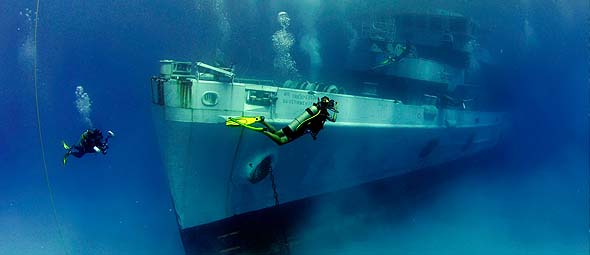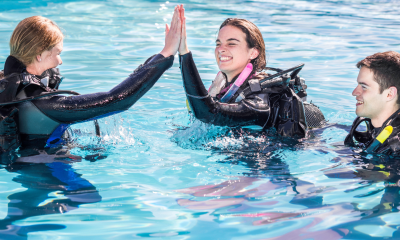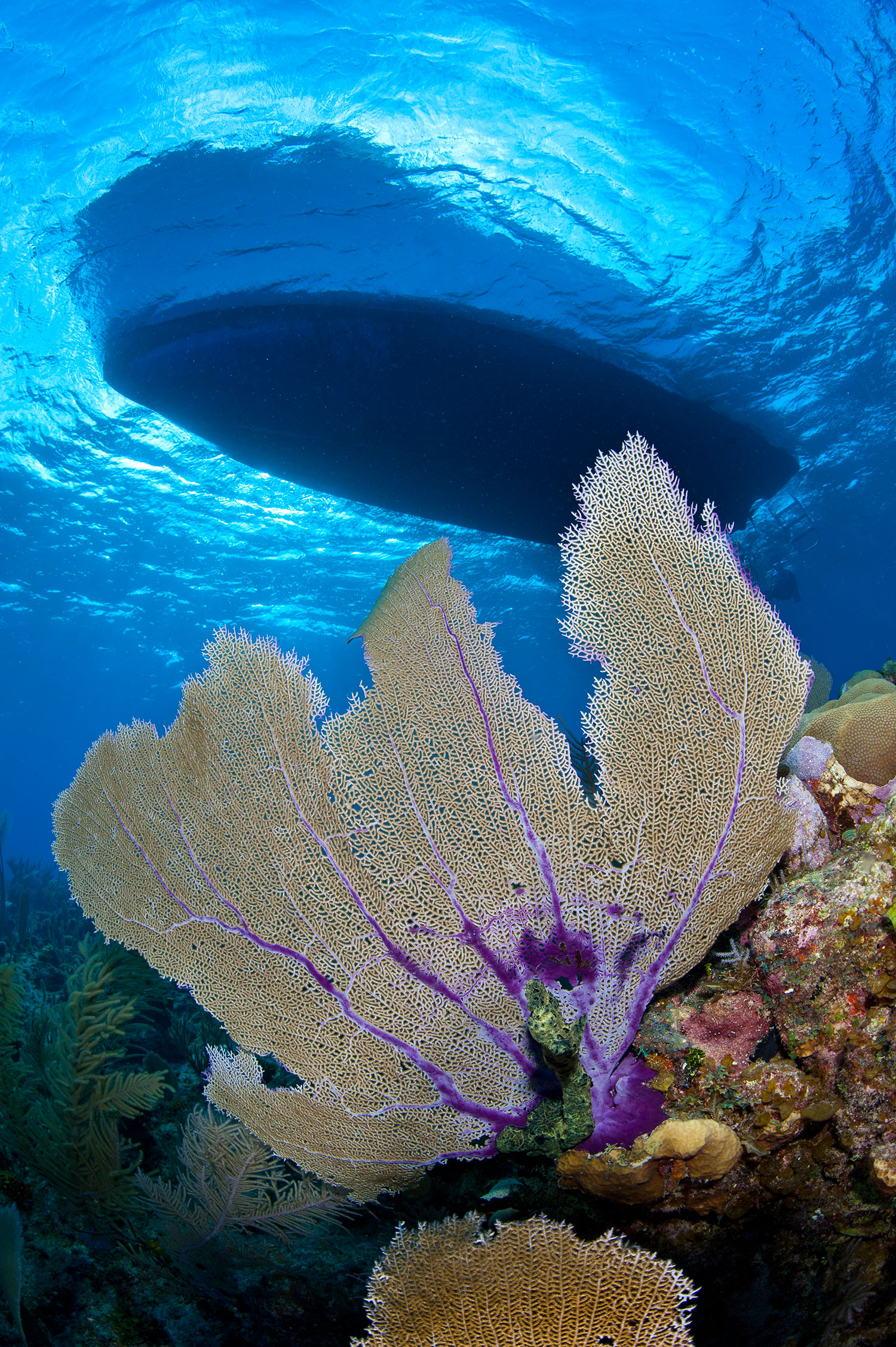News
Dive into the Cayman Islands this October with Legends and Lions: a weeklong celebration of Cayman diving

Long recognized as the birthplace of recreational diving and renowned for its exceptional and diverse diving, the Cayman Islands’ dive industry is inviting all divers to join them in a weeklong celebration of the sport called Legends and Lions.
Taking place from the 4th – 11th October 2014, the inaugural dive festival will showcase Cayman’s superb dive product, honor dive legends being inducted into the International Scuba Diving Hall of Fame, give attendees the chance to join the fight against invasive Lionfish and feature incredible savings in dive packages offered by Cayman’s top dive operators Red Sail Sports, Divetech, Ocean Frontiers and Sunset House.
“It is only logical that one of the world’s top scuba diving destinations should have an annual festival celebrating the sport and highlighting Cayman’s fantastic marine world,” said Red Sail Sports Operations Manager Rod McDowall.
Teaming up with the Cayman Islands Department of Tourism, the dive industry leaders are bringing together several existing scuba promotions during this traditionally slow time of year to take advantage of excellent off-season rates for this scuba week. Legends and Lions will feature plenty of excellent diving and a number of special topside events. Conservation-minded divers can join the frontline in the battle against the invasive Lionfish – threatening all Caribbean reefs – with a Lionfish culling certification and then removing the pesky predators from local reefs. But that’s not all – the day’s fresh Lionfish catch will be cooked up and enjoyed during a street party hosted by local artist and environmentalist Guy Harvey.
To cap off this scuba week celebration, participants will attend the International Scuba Diving Hall of Fame Induction Dinner, where some of the biggest names in the dive industry will be honored. Cayman is host to the International Scuba Diving Hall of Fame and all Legends and Lions participants will be invited to attend. These year’s inductees are Alese and Mort Pechter, Bill Acker, Chuck Nicklin, Dan Orr and Neal Watson.
“Divers from around the world will have the opportunity to dive with a dive legend who helped create the sport we all love, and diving with a legend is something you cannot do anywhere,” said Sunset House General Manager Keith Sahm. “Here in the Cayman Islands each attendee will not only be able to dive with them, but they’ll also get a chance to mingle with these dive pioneers when they attend the Awards Night dinner as part of their Legends and Lions package.”
Also invited to attend the festival on a familiarization trip are the top performers from dive shops and booking agents who have participated in Cayman’s Tanks A Lot Rewards Program.
Taking advantage of shoulder season rates, Legends and Lions dive packages offer an excellent price for a 7-day stay. The packages include six daily 2-tank dives to the island’s top dive sites, a dive on the ex-USS Kittiwake wreck, a Lionfish certification with Lionfish Hunt Dive Competition, Lionfish Dinner with Underwater Photo Competition, International Scuba Diving Hall of Fame Induction Dinner and assorted on-island discounts.
Cayman’s leading dive operators are pulling out all the stops to ensure everyone enjoys an unforgettable dive vacation. Red Sail Sports is adding a free Sunset Sail aboard a luxury Catamaran and a 20% discount on beach toys at all its beach locations. Divetech’s package offers a full meal plan, unlimited shore diving, a dive on the underwater sculpture ‘Guardian of the Reef’, and a pool rebreather test and demonstration. Sunset House’s perks include a Stingray City dive, an afternoon dive on the USS Kittiwake, unlimited shore diving, DAN insurance for an additional $40, plus a welcome drink and gift. Ocean Frontiers’ package added-value offerings include a car rental for the entire stay, shore diving, a catamaran sail and a bottle of wine.
Leading dive operators hope to grow Legends and Lions into the destination’s signature annual dive event promoting its best natural resources – Cayman’s spectacular underwater world, presented by the best dive operators in the business, topped off with exceptional Caymanian hospitality.
“It should soon be on every divers calendar – fantastic diving and accommodations, great air connections, the chance to meet industry celebrities and greats, help the environment by culling and eating the dreaded Lionfish, party and have fun in the Caribbean – what more would you want?” asked Rod McDowall.
To book a Legends and Lions package visit www.divecayman.ky/scubaweek.
News
Book Review: Fire on Monroe Bravo by Fred Lockwood

Fire on Monroe Bravo is the latest book in the Jack Collier series by Fred Lockwood. Our story begins with our lead characters, Jack and Sandro, owners of Marine Salvage & Investigation Company, arriving on the Monroe Bravo Oil & Gas Platform in the North Sea. Having secured a contract for their vessel the MV Stavanger to act as support ship to the platform for TransGlobal Oil, our protagonists are on a celebratory visit.
However almost as soon as they arrive a series of explosions rock the platform, causing huge damage, loss of life and the very real danger of a massive human, ecological and financial disaster.

As the danger mounts for both our heroes and the surviving workers, Jack and Sandro will have to escape the inferno, all while trying to save the platform and the men still trapped unable to help themselves.
The disaster sets the scene for the unfolding story lines following the fate of the platform and our main characters, the police investigation into a suspected terrorist act and the actions of TransGlobal Oil as they attempt to navigate the pubic outcry and financial repercussions.
In his eighth book, Fire on Monroe Bravo, Fred Lockwood delivers an explosive thriller, with plenty of above and in-water drama, and our heroes fighting for survival, what more can you ask for?
We thoroughly recommend this read and look forward to the next in the series. For more information about his book series, you can check out the reviews of his previous books here on Scubaverse.
- Title: Fire On Monroe Bravo
- Author: Fred Lockwood
- ISBN: 979-8325324536
Available in a paperback version and for Kindle from Amazon and book stores.
Blogs
Alonissos: The complete diving destination (Part 1)

In June we were incredibly fortunate to be invited to dive in Alonissos, a small Greek Island in the Sporades island chain located in the North Aegean Sea. While I have long been a big fan of the Greek Islands as a great holiday destination, I had not had the opportunity to do any diving on previous visits and Mike and I were extremely excited to see what Alonissos had to offer both above and below the surface!

The Sporades are easily accessible via the airport in Skiathos (the first island in the chain), which is served by Jet2 flights from all major UK airports from May through October. Numerous ferries and charter boats make island hopping from Skiathos Town a breeze. After an hour boat ride, the picturesque port of Patitiri was a wonderful introduction to Alonissos, where we were met by our gracious hosts Kostas of Albedo Travel and Dias of Alonissos Triton Dive Center. Mike and I were delighted to be staying at the Paradise Hotel, aptly named for its stunning views over the sea and great location for walking to the waterfront.

Alonissos is beautifully situated in the National Marine Park of Alonissos and the Northern Sporades, the largest marine protected area in Europe. The surrounding seas offer fabulous marine life, including incredibly rare species such as the Mediterranean monk seal. They boast deep walls covered in gorgonians and sponges, stunning topography with caverns, swimthroughs and pinnacles, and the first accessible ancient shipwreck from 500BC!

In locations where historical sites have been reported, the waters are largely restricted, but with collaboration between government, underwater archeologists and dive centres, incredible underwater museums are being created for a truly unique diving experience. Alonissos is home to the first of these, the Ancient Shipwreck of Peristera Accessible Underwater Archeological Site. The chance to dive into history (along with reports of healthy reef life and amazing underwater topography) meant Mike and I were keen to get in the water.

Our introduction to the diving around Alonissos was at the Agios Georgios Pinnacles, in the channel between Alonissos and Skopelos. This fantastic site was named “The Chimney,’ and proved to have a huge amount to see. We got to a decent depth here (over 25m), and marvelled at a colourful reef wall with a wonderful swim through whose rocky walls were absolutely covered with life. As well as brilliant topography there was no shortage of macro life here. We saw numerous nudibranchs, five different species in total. The second dive at Mourtias reef nearby was a shallower dive along a nice wall with lots of crevices. Several moray eels and grouper called this site home. We enjoyed looking in the crevices for lobster and smaller benthic life, such as cup corals and tunicates.

Our itinerary allowed us two dives a day with afternoons left to explore the island with our hire car and evenings to enjoy the famous Greek hospitality. This proved to be a lovely mix of in-water and land based diversions.

The next days diving to the Gorgonian Gardens and Triton’s Cave was to be even better! These two stunning sites are nothing short of fabulous. The Gorgonian Gardens was a deep wall near to the Agios Georgios islands. The ever-present currents in this deep channel meant that the sea life was amazing … the namesake Gorgonian sea fans dotted the wall at a depth of 30 to 50 meters, getting ever larger the deeper we went. Above 30m was by no means less beautiful, with sponges, corals, scorpionfish, moray eels and some rare and colourful nudibranchs.

The second shallower dive of the day was to Triton’s Cave or the Cavern of Skopelos, on the east side of that island. The spectacular rock formations had wild striations both above and below the water making a truly epic topography. The cavern entrance was at 14m, and big enough for a buddy pair, winding up to 6m and passing two beautiful windows out into the blue. Emerging from the cavern, the light at the shallower depths and the incredible rock formations made for a fantastic gentle swimming safety stop and we all surfaced by the boat with massive grins.

Check out our next blog :Alonissos: The complete diving destination (Part 2)” to hear about our amazing dive on the 2500 year old Peristera Wreck!
Thanks to:
Alonissos Triton Dive Center https://bestdivingingreece.com/
Albedo Travel https://alonissosholidays.com/activities/
Paradise Hotel https://paradise-hotel.gr/
Alonissos Municipality https://alonissos.gr/en/
-

 Blogs2 months ago
Blogs2 months agoDiving With… Nico, Ocean Earth Travels, Indonesia
-

 News1 month ago
News1 month agoMurex Bangka Announce New Oceanfront Cottages & Beachfront Dining
-

 Blogs2 months ago
Blogs2 months agoA new idea in freediving from RAID
-

 Marine Life & Conservation1 month ago
Marine Life & Conservation1 month agoIceland issue millionaire whale hunter a licence to murder 128 vulnerable fin whales
-

 Marine Life & Conservation2 months ago
Marine Life & Conservation2 months agoThe Shark Trust Great Shark Snapshot is back
-

 News3 months ago
News3 months agoCharting New Waters; NovoScuba Goes Global with the Launch of their Revolutionary Dive Training Agency!
-

 Gear News1 month ago
Gear News1 month agoNew Suunto Ocean – a dive computer and GPS sports watch in one for adventures below and above the surface
-

 Marine Life & Conservation Blogs2 months ago
Marine Life & Conservation Blogs2 months agoBook Review: Plankton
















